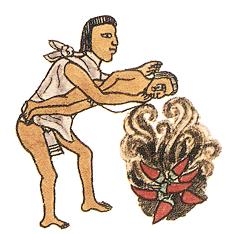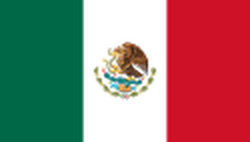Mexico
| United Mexican States |
|
(and Mexico's largest city) |
Source information is available at [ Sources ] |
Mexico, officially the United Mexican States, is a country in the southern portion of North America. It is bordered to the north by the United States, to the south and west by the Pacific Ocean, to the southeast by Guatemala, Belize, and the Caribbean Sea, and to the east by the Gulf of Mexico. Mexico covers 1,972,550 square kilometers (761,610 sq mi), making it the world's 13th-largest country by area; with approximately 126,014,024 inhabitants, it is the 10th-most-populous country with the most Spanish speakers. Mexico is a federation comprising 31 states and Mexico City, its capital and largest metropolis. Other major urban areas include Guadalajara, Monterrey, Puebla, Toluca, Tijuana, Ciudad Juárez, and León.
History
Pre-Columbian Mexico traces its origins to 8,000 BC and is identified as one of the six cradles of civilization; it was home to many advanced Mesoamerican civilizations, most notably the Maya and the Aztecs. In 1521, the Spanish Empire conquered and colonized the region from its base in Mexico City, establishing the colony of New Spain. The Catholic Church played an important role in spreading Christianity and the Spanish language while also preserving some indigenous elements. Native populations were subjugated and heavily exploited to mine rich deposits of precious metals, which contributed to Spain's status as a significant world power for the next three centuries and to a massive influx of wealth and a price revolution in Western Europe. Over time, a distinct Mexican identity formed, based on a fusion of European and indigenous customs; this contributed to the successful Mexican War of Independence against Spain in 1821.
Mexico's early history as a nation-state was marked by political and socio-economic upheaval. The Texas Revolution and the Mexican–American War in the mid-19th century led to substantial territorial losses to the United States. Liberal reforms were enshrined in the Constitution of 1857, which sought to integrate indigenous communities and curtail the power of the church and the military. This triggered an internal war of Reform and intervention by France, in which conservatives installed Maximilian Habsburg as emperor against the Republican resistance led by Benito Juárez. The last decades of the 19th century were marked by the dictatorship of Porfirio Díaz, who sought to modernize Mexico and restore order. The Porfiriato era ended in 1910 with the decade-long Mexican Civil War, which killed approximately 10% of the population and after which the victorious Constitutionalist faction drafted a new 1917 Constitution, which remains in effect to this day. The revolutionary generals ruled as a succession of presidents until Alvaro Obregón was assassinated in 1928. This led to the formation of the Institutional Revolutionary Party the following year, which governed Mexico until 2000.
No official national language exists, but Spanish is the de facto national language.
Spanking in Mexico

The Aztecs had various methods of corporal punishment, some of which were quite different from those in the rest of the world, such as the "smoke punishment" (see image to the right).
The Spaniards invaded Mexico in the 16th century and made the country a part of the Spanish Empire. They introduced Europe a corporal punishment method. Today's Mexican culture is a blend of pre-Hispanic and Spanish culture.
Mexican parents can be tough on their kids; they believe children should be well-behaved, and in general, they believe in corporal punishment. Spanking is widespread and often given bare bottom (a nalga pelona). Mexican immigrants to the U.S. often complain that U.S. laws don't permit them to discipline their kids as sternly as they did in Mexico.[1].
Mexican spanking art
In the 20th century, school corporal punishment fell out of fashion and was gradually banned in many countries, a trend that continues until the present day.
As of May 2008, Mexico permits corporal punishment in schools.
Mexican spanking artists include El Manto Negro and Oscar.
Spanking videos
- Amy's Cancún Caning (Triple A Spanking, 2022), Amy Fox, photos
- Bathbrush Spanking for Carmen and Sofia (Spank Latinas, 2023), photos, Clips4Sale site
- Custom Order 74 (Spank Latinas), Carmen, Sofia, over-one-knee position, photos
- Custom Order 84 (Spank Latinas, 2024), Carmen, Sofia, silicone spatula used in sitting-with-bottom-out position (photos)
- Daniella Got in Trouble for Not Cleaning Her Room Again (Latin Spanking), hair pulling, photos
- Daniella Punished for Not Cleaning the House (Latin Spanking, 2019), photos
- Daniellas's Hard Punishment Until She Cries (Latin Spanking, 2020), hair pulling, photos, part 2 photos
- Denise Interview (Amateur Spankings, 2019), photos
- Denise's Homework (Amateur Spankings, 2019), photos
- Hanna's Debut - Spanking at the Haunted House Series (Latin Spanking), photos
- Latin Spanking Halloween Party – Diablita Fresita (Latin Spanking), Halloween, photos
- Niny and Mimi Christmas Paddling (Latin Spanking, 2020), Christmas, photos
- Uncompromising Caning (Punished Girls), photos
Prostitution in Mexico
- Prostitution in Mexico ↗ on Wikipedia
Sources
References
- ↑ Source: http://www.corpun.com/usd00003.htm
External links
- Spanking: An Idea Whose Time Has Gone - an article by Agustin Gurza on World Corporal Punishment Research
- CIA Factbook link for Mexico
- Images from Mexico on Bing.com
- More information is available at [ Wikipedia:Mexico ]
Chat rooms • What links here • Copyright info • Contact information • Category:Root

